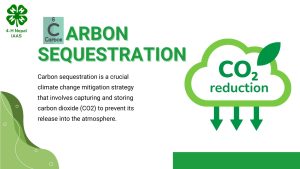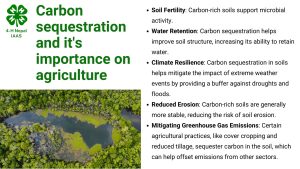“Carbon Sequestration” is highly relevant and important in the context of contemporary agricultural practices and climate change mitigation strategies. As part of the Agri-Insights Series by 4H Nepal IAAS Section Lamjung, discussing this topic can provide valuable insights and knowledge sharing, especially for those involved in agriculture, environmental science, and sustainability.
Here are some key points that might be discussed in this week’s digital presentation:
- Understanding Carbon Sequestration: Begin with a basic introduction to what carbon sequestration is – the process of capturing and storing atmospheric carbon dioxide (CO2). It’s one of the ways to reduce the amount of CO2 in the atmosphere to reduce global climate change.
- Methods of Carbon Sequestration: Discuss both natural and artificial methods. Natural processes include photosynthesis in plants and trees. Artificial methods can involve technologies that capture and store CO2 from power plants or directly from the air.
- Role of Agriculture in Carbon Sequestration: Agriculture can play a significant role in carbon sequestration. Practices like agroforestry, no-till farming, cover cropping, and the use of organic fertilizers help increase carbon storage in soils.
- Benefits for Farmers: Highlight the benefits for farmers, such as improved soil health, increased biodiversity, and potentially new revenue streams through carbon credits.
- Challenges and Limitations: Discuss the challenges in implementing carbon sequestration techniques, including economic costs, technological barriers, and the need for education and training for farmers.
- Case Studies and Examples: Share successful examples or case studies, especially those relevant to Nepal or similar agricultural contexts, to illustrate how carbon sequestration can be effectively implemented.
- Policy and Incentives: Explore the role of government policies and incentives in promoting carbon sequestration practices among farmers and in the agricultural sector.
- Future Prospects and Research: Discuss ongoing research, technological advancements, and prospects in the field of carbon sequestration.
- Interactive Segment: Engage the audience with Q&A sessions, quizzes, or interactive discussions to make the session more engaging and informative.
- Resources and Further Learning: Provide resources for further learning, such as articles, books, online courses, and organizations working in the field of carbon sequestration.

This week of Agri-Insights endeavours to delve into the critical subject of Carbon Sequestration, elucidating its pivotal role in addressing climate change within the context of agriculture.
Our primary objective is to furnish our audience with comprehensive knowledge, emphasizing the interconnection between carbon sequestration, climate change mitigation, and sustainable agricultural practices.
Through this initiative, we aim to equip individuals with insights that foster informed decision-making and the adoption of eco-conscious methodologies in farming practices.
